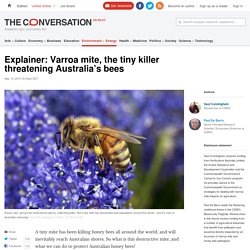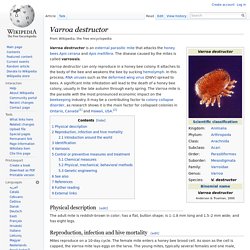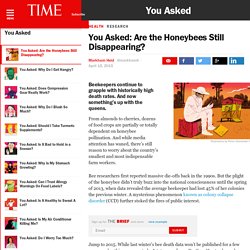

Explainer: Varroa mite, the tiny killer threatening Australia's bees. A tiny mite has been killing honey bees all around the world, and will inevitably reach Australian shores.

So what is this destructive mite, and what we can do to protect Australian honey bees? The Varroa mite, also known as Varroa destructor, is only the size of a pin head but it is the most serious threat to the viability of the Australian honey bee industry. The mite is parasitic and feeds on the blood of adult and larval honey bees. It also transmits viral and other pathogens, which kill entire bee colonies. Varroa mites « Bee Aware. Life cycleEffectDetectionSpread & distributionOverseas experiencesResponseAdditional informationVideos Life cycle Different life stages of Varroa mites at the bottom of a brood cell.

CSIRO. Varroa destructor. Varroa destructor is an external parasitic mite that attacks the honey bees Apis cerana and Apis mellifera.

The disease caused by the mites is called varroosis. Varroa destructor can only reproduce in a honey bee colony. It attaches to the body of the bee and weakens the bee by sucking hemolymph. You Asked: Are the Honeybees Still Disappearing? From almonds to cherries, dozens of food crops are partially or totally dependent on honeybee pollination.

And while media attention has waned, there’s still reason to worry about the country’s smallest and most indispensable farm workers. Bee researchers first reported massive die-offs back in the 1990s. But the plight of the honeybee didn’t truly buzz into the national consciousness until the spring of 2013, when data revealed the average beekeeper had lost 45% of her colonies the previous winter. A mysterious phenomenon known as colony collapse disorder (CCD) further stoked the fires of public interest. Jump to 2015. Honey Bees and Colony Collapse Disorder. Honey bees, which are a critical link in U.S. agriculture, have been under serious pressure from a mystery problem: Colony Collapse Disorder (CCD), which is syndrome defined as a dead colony with no adult bees or dead bee bodies but with a live queen and usually honey and immature bees still present.

No scientific cause for CCD has been proven. But CCD is far from the only risk to the health of honey bees and the economic stability of commercial beekeeping and pollination operations in the United States. Since the 1980s, honey bees and beekeepers have had to deal with a host of new pathogens from deformed wing virus to nosema fungi, new parasites such as Varroa mites, pests like small hive beetles, nutrition problems from lack of diversity or availability in pollen and nectar sources, and possible sublethal effects of pesticides. Contents. Colony collapse disorder. Honey bees at a hive entrance: One is about to land and another is fanning.

Colony collapse disorder (CCD) is the phenomenon that occurs when the majority of worker bees in a colony disappear and leave behind a queen, plenty of food and a few nurse bees to care for the remaining immature bees. Colony collapse disorder causes significant economic losses because many agricultural crops worldwide are pollinated by western honey bees. According to the Agriculture and Consumer Protection Department of the Food and Agriculture Organization of the United Nations, the worth of global crops with honey bee pollination was estimated at close to $200 billion in 2005.[9] Shortages of bees in the US have increased the cost to farmers renting them for pollination services by up to 20%.[10] In the six years leading up to 2013, more than 10 million beehives were lost, often to CCD,[11] nearly twice the normal rate of loss.